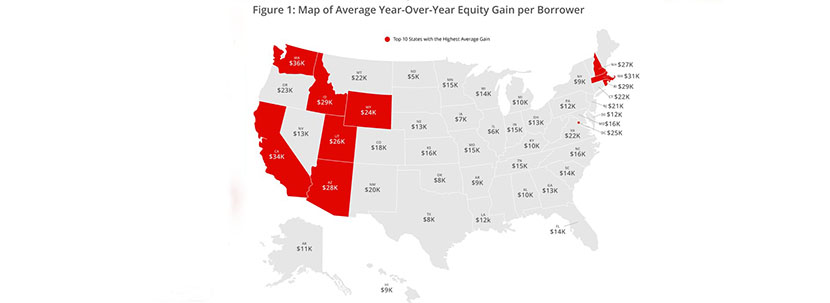
Home Equity Reaches Record High: Homeowners Gained $1 Trillion in 3Q Equity

CoreLogic, Irvine, Calif., said U.S. homeowners with mortgages saw their equity increase by 10.8% year over year in the third quarter—a collective equity gain of $1 trillion and an average gain of $17,000 per homeowner.
The company’s quarterly Home Equity Report said this marks the largest average equity gain since first quarter 2014.
Homeowners with mortgages account for 63% of all U.S. properties.
CoreLogic said despite the economic impact of the pandemic, home prices soared throughout the summer and fall. Appreciation reached its highest level since 2014 in the third quarter as prospective homebuyers continued to compete for low supply of homes on the market, pushing home equity to record levels.
CoreLogic Chief Economist Frank Nothaft said equity gains are likely to persist over the next several months as strong home-purchase demand is expected to remain high and continue pushing prices up. However, the CoreLogic HPI Forecast shows home prices slowing over the next 12 months as new home construction and more existing for-sale homes ease supply pressures. He said this could moderate the pace of both home price growth and equity gains.
Over the past year, strong home price growth has created a record level of home equity for homeowners, Nothaft noted; the average family with a home mortgage loan had $194,000 in home equity in the third quarter. “This provides an important buffer to protect families if they experience financial difficulties, and is one reason for the generational-low in foreclosure rates reported in September,” he said.
The report said the share of homes with negative equity (referred to as underwater or upside down) also continued to drop:
–From the second quarter to the third quarter, the total number of mortgaged homes in negative equity decreased by 6.9% to 1.6 million homes or 3% of all mortgaged properties.
–A year ago, 2 million homes, or 3.7% of all mortgaged properties, were in negative equity. This number decreased by 18.3%, or 370,000 properties, in the third quarter to 1.6 million mortgaged properties in negative equity.
The national aggregate value of negative equity fell to $283.3 billion at the end of the third quarter, down by $2.2 billion, or 0.8%, from $285.5 billion in the second quarter and down by $21.4 billion, or 7%, from $304.7 billion a year ago.
“The housing market has remained a strong pillar in an otherwise tumultuous economic year,” said Frank Martell, president and CEO of CoreLogic. “A sharp rise in demand, spurred by record-low interest rates, continues to bolster homeowner equity. And with many people now spending more time than ever before at home, some homeowners have tapped into their strengthening equity to fund renovations.”
The report said because home equity is affected by home price changes, borrowers with equity positions near (+/-5%) the negative equity cutoff are most likely to move out of or into negative equity as prices change. CoreLogic said if home prices increase by 5%, 247,000 homes would regain equity; if home prices decline by 5%, 337,000 would fall underwater.
States with strong home price growth and high home prices continued to experience the largest gains in equity. This includes Washington, where homeowners gained an average of $35,800; California, where homeowners gained an average of $33,800 and Massachusetts, where homeowners gained an average of $31,200. Meanwhile, North Dakota, which was hit hard by the pandemic, experienced the lowest annual equity gain (averaging just $5,400) in the third quarter.
